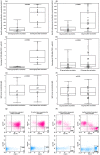Antibody and plasmablast response to 13-valent pneumococcal conjugate vaccine in chronic lymphocytic leukemia patients--preliminary report
- PMID: 25506837
- PMCID: PMC4266633
- DOI: 10.1371/journal.pone.0114966
Antibody and plasmablast response to 13-valent pneumococcal conjugate vaccine in chronic lymphocytic leukemia patients--preliminary report
Abstract
Background: Chronic lymphocytic leukemia (CLL) leads to significant immune system dysfunction. The predominant clinical presentation in 50% of patients involves recurrent, often severe, infections. Infections are also the most common (60-80%) cause of deaths in CLL patients. The scope of infections varies with the clinical stage of the disease. Treatment-naive patients typically present with respiratory tract infections caused by encapsulated bacteria Streptococcus pneumoniae and Haemophilus influenzae. Since 2012, the 13-valent pneumococcal conjugate vaccine (PCV13) has been recommended in the United States and some EU countries for pneumococcal infection prevention in patients with CLL (besides the long-standing standard, 23-valent pneumococcal polysaccharide vaccine, PPV23). The aim of this study was to compare the immune response to PCV13 in 24 previously untreated CLL patients and healthy subjects.
Methods: Both groups were evaluated for: the levels of specific pneumococcal antibodies, the levels of IgG and IgG subclasses and selected peripheral blood lymphocyte subpopulations including the frequency of plasmablasts before and after immunization.
Results: Adequate response to vaccination, defined as an at least two-fold increase in specific pneumococcal antibody titers versus pre-vaccination baseline titers, was found in 58.3% of CLL patients and 100% of healthy subjects. Both the CLL group and the control group demonstrated a statistically significant increase in the IgG2 subclass levels following vaccination (P = 0.0301). After vaccination, the frequency of plasmablasts was significantly lower (P<0.0001) in CLL patients in comparison to that in controls. Patients who responded to vaccination had lower clinical stage of CLL as well as higher total IgG, and IgG2 subclass levels. No significant vaccine-related side effects were observed.
Conclusions: PCV13 vaccination in CLL patients is safe and induces an effective immune response in a considerable proportion of patients. To achieve an optimal vaccination response, the administration of PCV13 is recommended as soon as possible following CLL diagnosis.
Conflict of interest statement
Figures

Similar articles
-
Pneumococcal conjugate vaccine triggers a better immune response than pneumococcal polysaccharide vaccine in patients with chronic lymphocytic leukemia A randomized study by the Swedish CLL group.Vaccine. 2018 Jun 14;36(25):3701-3707. doi: 10.1016/j.vaccine.2018.05.012. Epub 2018 May 7. Vaccine. 2018. PMID: 29748028
-
Improved plasmablast response after repeated pneumococcal revaccinations following primary immunization with 13-valent pneumococcal conjugate vaccine or 23-valent pneumococcal polysaccharide vaccine in patients with chronic lymphocytic leukemia.Vaccine. 2023 May 5;41(19):3128-3136. doi: 10.1016/j.vaccine.2023.04.016. Epub 2023 Apr 13. Vaccine. 2023. PMID: 37061372
-
Antibody response to the 23-valent pneumococcal polysaccharide vaccine after conjugate vaccine in patients with chronic lymphocytic leukemia.Hum Vaccin Immunother. 2019;15(12):2910-2913. doi: 10.1080/21645515.2019.1627160. Epub 2019 Jul 9. Hum Vaccin Immunother. 2019. PMID: 31216225 Free PMC article.
-
Immunogenicity and safety of the 13-valent pneumococcal conjugate vaccine compared to 23-valent pneumococcal polysaccharide in immunocompetent adults: A systematic review and meta-analysis.Vaccine. 2019 Feb 14;37(8):1021-1029. doi: 10.1016/j.vaccine.2019.01.014. Epub 2019 Jan 23. Vaccine. 2019. PMID: 30685252
-
Pneumococcal polysaccharide conjugate vaccine (13-valent, adsorbed) [prevenar 13®].Drugs. 2010 Oct 22;70(15):1973-86. doi: 10.2165/11205110-000000000-00000. Drugs. 2010. PMID: 20883054 Review.
Cited by
-
Coronavirus-Specific Antibody and T Cell Responses Developed after Sputnik V Vaccination in Patients with Chronic Lymphocytic Leukemia.Int J Mol Sci. 2022 Dec 27;24(1):416. doi: 10.3390/ijms24010416. Int J Mol Sci. 2022. PMID: 36613860 Free PMC article.
-
Disseminated cryptococcal infection in a patient with treatment-naïve chronic lymphocytic leukemia (CLL).IDCases. 2019 May 31;17:e00566. doi: 10.1016/j.idcr.2019.e00566. eCollection 2019. IDCases. 2019. PMID: 31194156 Free PMC article.
-
Association between PCV13 pneumococcal vaccination and risk of hospital admissions due to pneumonia or sepsis among patients with haematological malignancies: a single-centre retrospective cohort study in Israel.BMJ Open. 2022 Apr 15;12(4):e056986. doi: 10.1136/bmjopen-2021-056986. BMJ Open. 2022. PMID: 35428637 Free PMC article.
-
Immunogenicity and safety of the 13-valent pneumococcal conjugate vaccine in patients with immunocompromising conditions: a review of available evidence.Hum Vaccin Immunother. 2020 Nov 1;16(11):2758-2772. doi: 10.1080/21645515.2020.1735224. Epub 2020 Jun 12. Hum Vaccin Immunother. 2020. PMID: 32530360 Free PMC article. Review.
-
COVID-19 in patients with CLL: improved survival outcomes and update on management strategies.Blood. 2021 Nov 4;138(18):1768-1773. doi: 10.1182/blood.2021011841. Blood. 2021. PMID: 34297826 Free PMC article. No abstract available.
References
-
- Linet MS, Schubauer-Berigan MK, Weisenburger DD, Richardson DB, Landgren O, et al. (2007) Chronic lymphocytic leukaemia: an overview of aetiology in light of recent developments in classification and pathogenesis. Br J Haematol 139:672–686. - PubMed
-
- Abbott BL (2006) Chronic lymphocytic leukemia: recent advances in diagnosis and treatment. Oncologist 11:21–30. - PubMed
-
- Oscier D, Fegan C, Hillmen P, Illidge T, Johnson S, et al. (2004) Guidelines on the diagnosis and management of chronic lymphocytic leukaemia. Br J Haematol 125:294–317. - PubMed
-
- Molica S (1994) Infections in chronic lymphocytic leukemia: risk factors, and impact on survival, and treatment. Leuk Lymphoma 13:203–214. - PubMed
Publication types
MeSH terms
Substances
LinkOut - more resources
Full Text Sources
Other Literature Sources
Medical

